Abstract
Many populations of amphibians are declining on all six continents on which they occur. Some causes of amphibian declines, such as habitat destruction, direct application of xenobiotics, and introduction of predators or competitors, are clearly attributable to human activities. Infectious disease appears to be the direct cause of mass amphibian die-offs in relatively undisturbed areas of the world where anthropomorphic environmental disruption is minimal. In these cases, it is not yet clear whether these epizootics result from the natural evolution of new pathogens or from environmental changes that promote the emergence of pathogenic forms and/or that weaken the immune defenses of amphibians. Because some aspects of pathogen-related amphibian mass mortalities are similar to outbreaks of new diseases in humans and coral reef organisms, amphibian declines may be part of a much larger pattern than previously appreciated.
Full text
PDF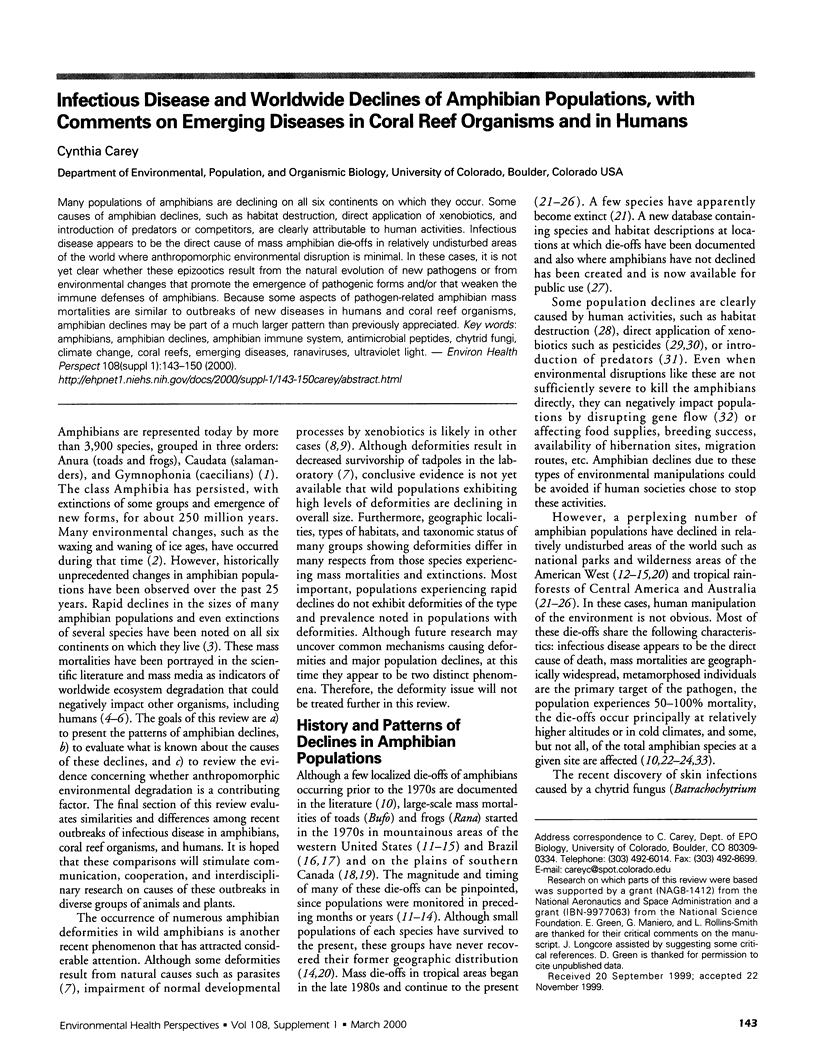
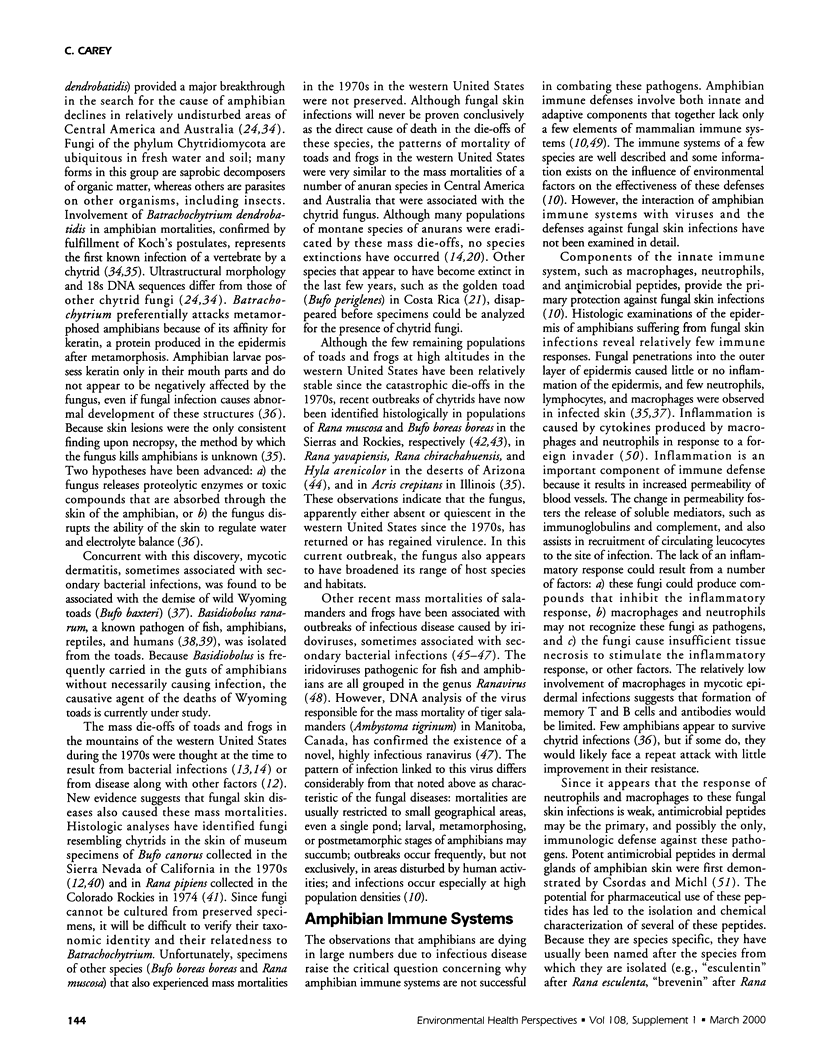
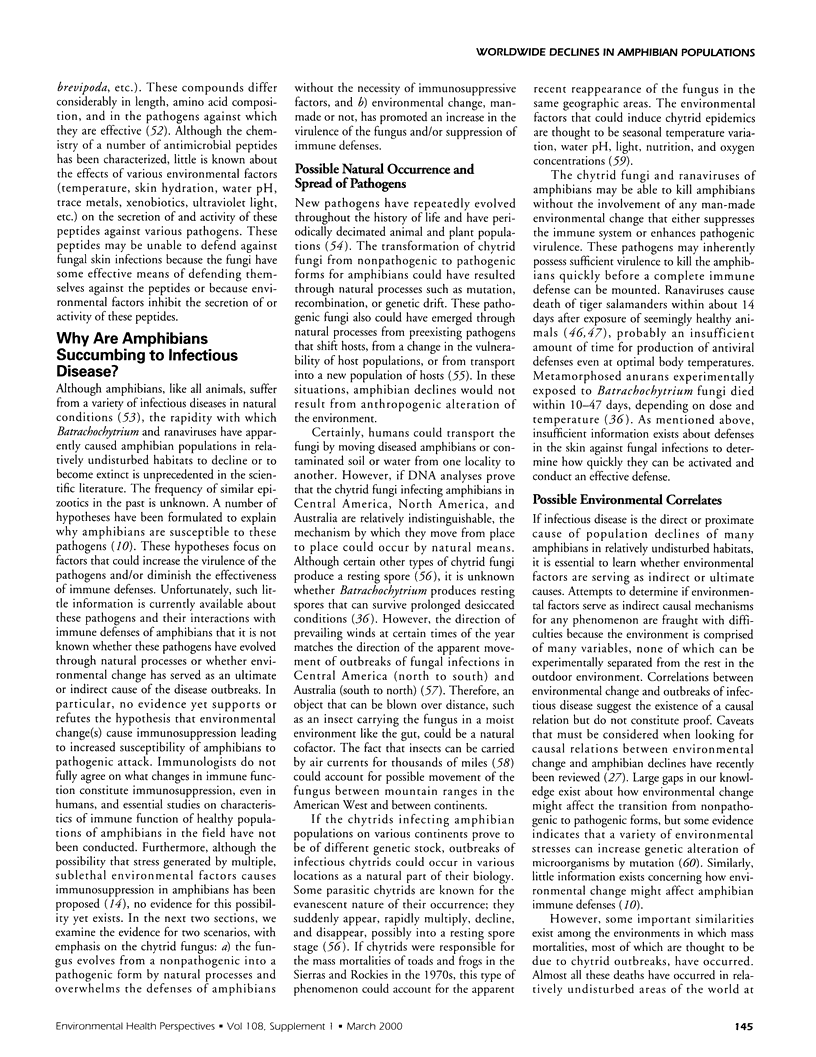

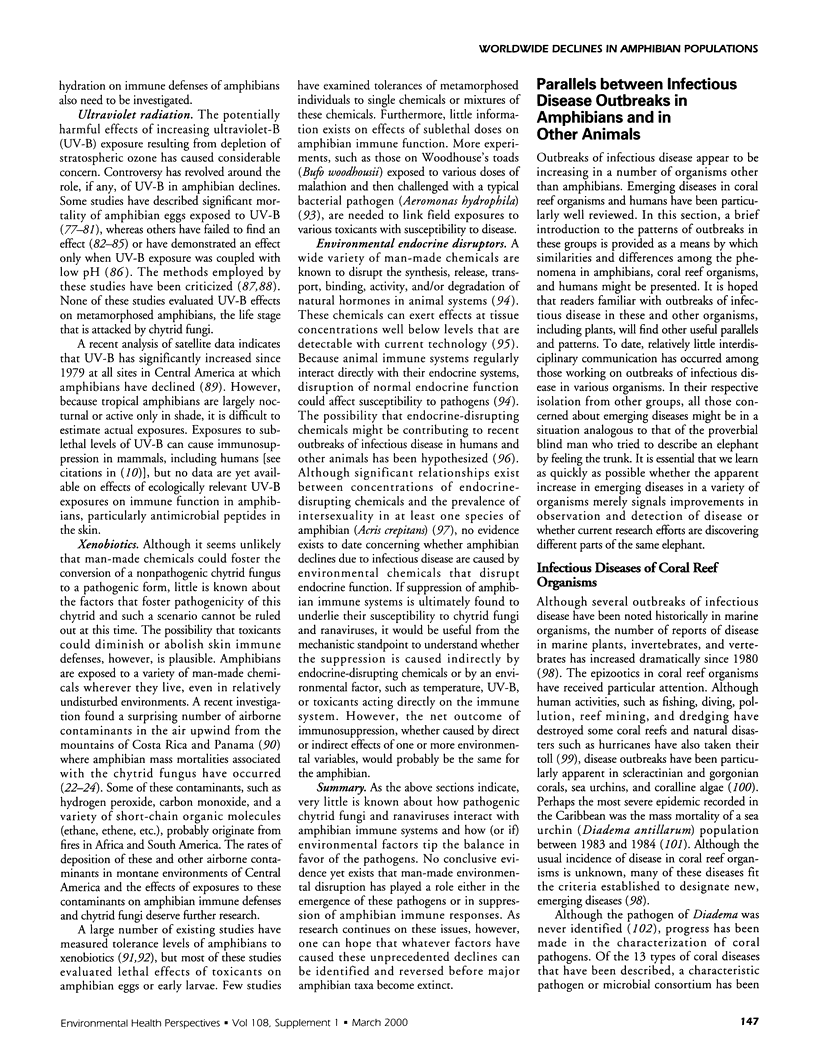
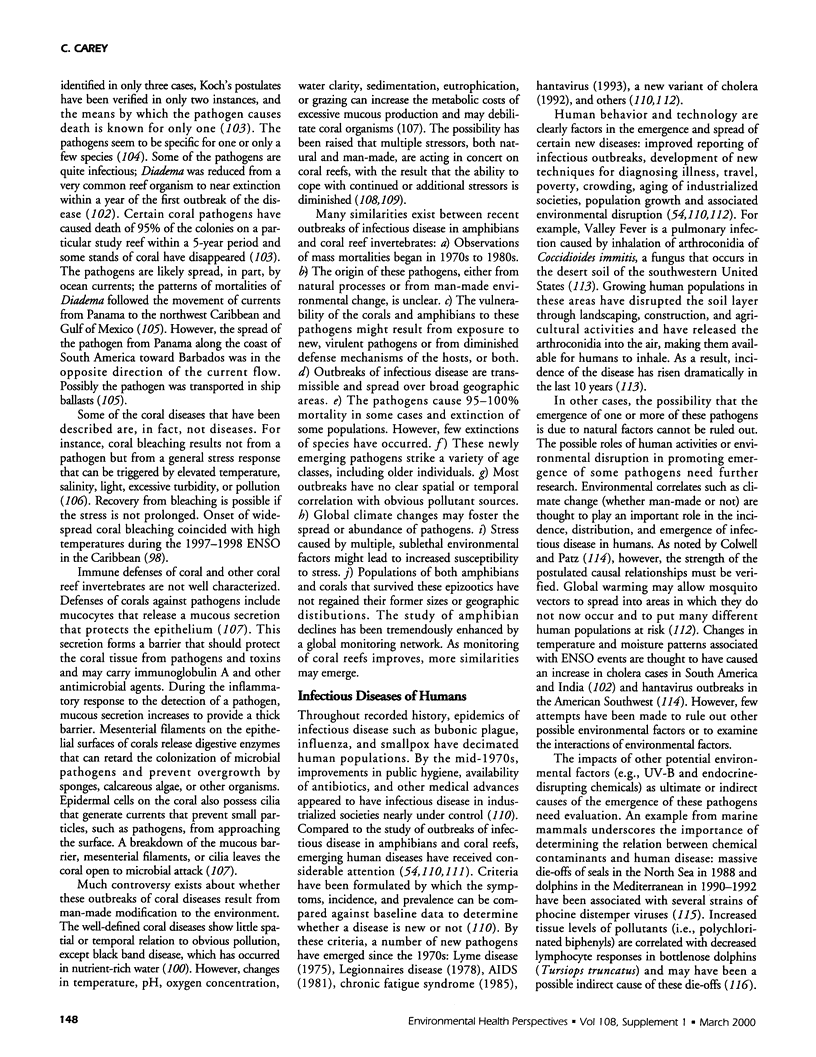
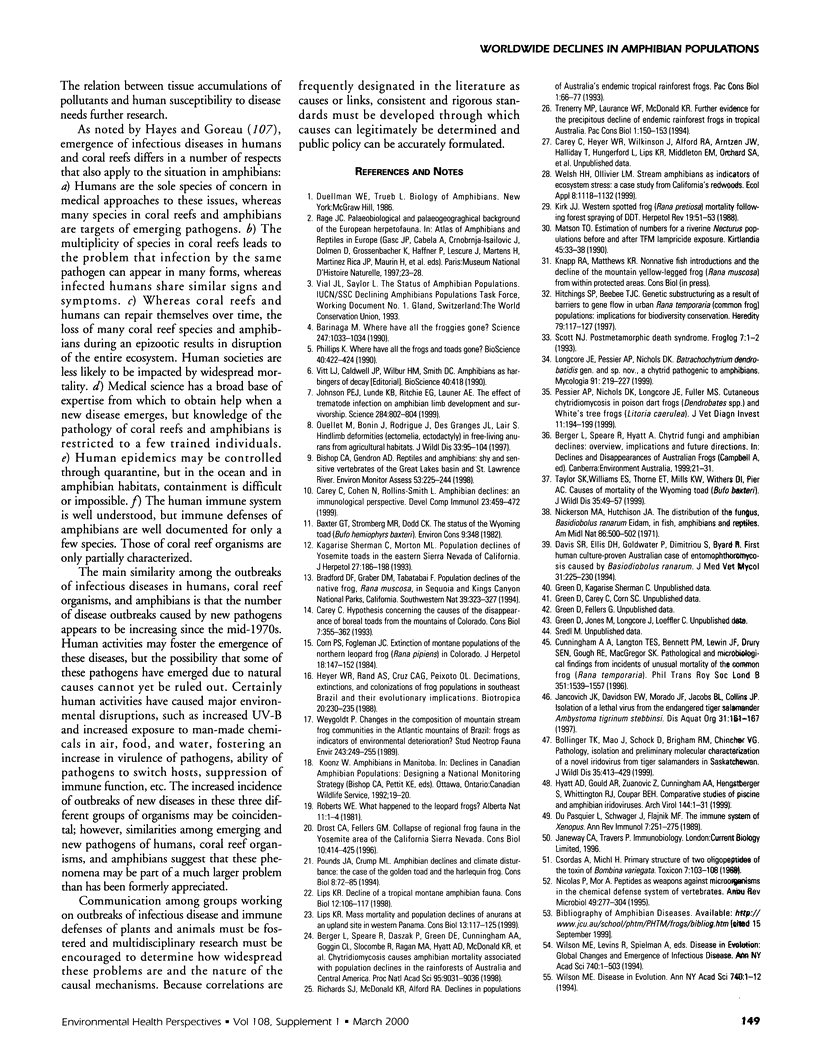
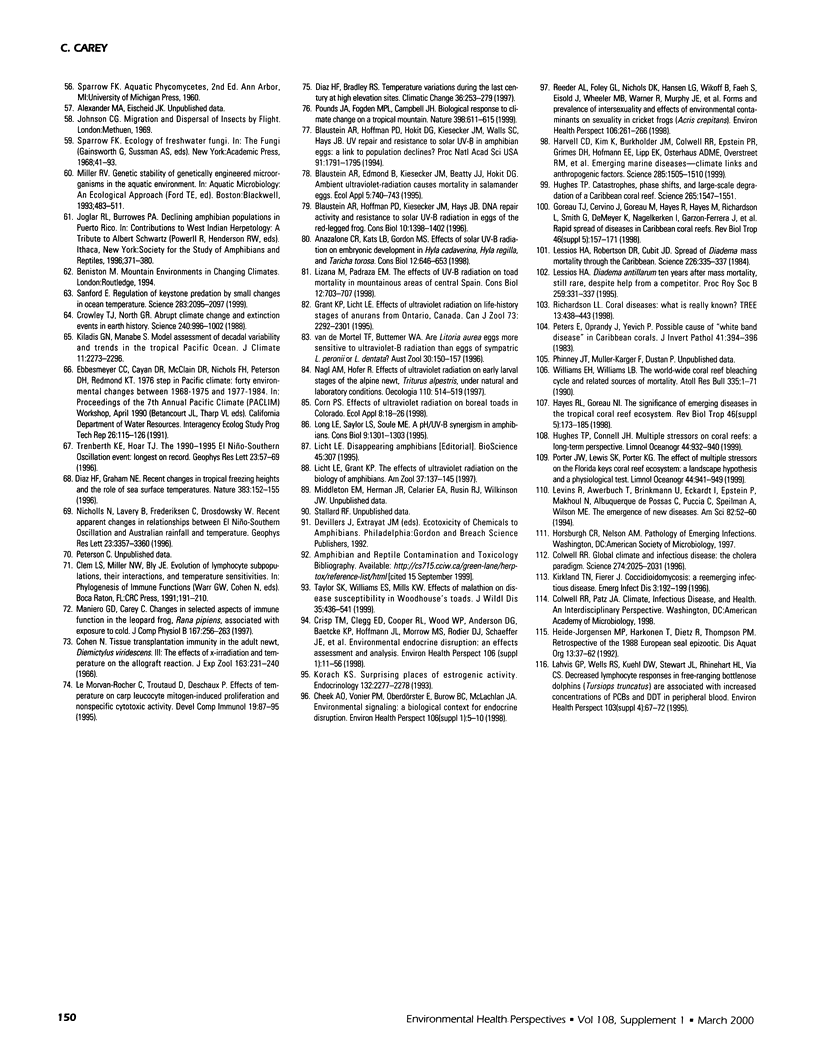
Selected References
These references are in PubMed. This may not be the complete list of references from this article.
- Barinaga M. Where have all the froggies gone? Science. 1990 Mar 2;247(4946):1033–1034. doi: 10.1126/science.247.4946.1033. [DOI] [PubMed] [Google Scholar]
- Berger L., Speare R., Daszak P., Green D. E., Cunningham A. A., Goggin C. L., Slocombe R., Ragan M. A., Hyatt A. D., McDonald K. R. Chytridiomycosis causes amphibian mortality associated with population declines in the rain forests of Australia and Central America. Proc Natl Acad Sci U S A. 1998 Jul 21;95(15):9031–9036. doi: 10.1073/pnas.95.15.9031. [DOI] [PMC free article] [PubMed] [Google Scholar]
- Blaustein A. R., Hoffman P. D., Hokit D. G., Kiesecker J. M., Walls S. C., Hays J. B. UV repair and resistance to solar UV-B in amphibian eggs: a link to population declines? Proc Natl Acad Sci U S A. 1994 Mar 1;91(5):1791–1795. doi: 10.1073/pnas.91.5.1791. [DOI] [PMC free article] [PubMed] [Google Scholar]
- Bollinger T. K., Mao J., Schock D., Brigham R. M., Chinchar V. G. Pathology, isolation, and preliminary molecular characterization of a novel iridovirus from tiger salamanders in Saskatchewan. J Wildl Dis. 1999 Jul;35(3):413–429. doi: 10.7589/0090-3558-35.3.413. [DOI] [PubMed] [Google Scholar]
- Cheek A. O., Vonier P. M., Oberdörster E., Burow B. C., McLachlan J. A. Environmental signaling: a biological context for endocrine disruption. Environ Health Perspect. 1998 Feb;106 (Suppl 1):5–10. doi: 10.1289/ehp.106-1533276. [DOI] [PMC free article] [PubMed] [Google Scholar]
- Colwell R. R. Global climate and infectious disease: the cholera paradigm. Science. 1996 Dec 20;274(5295):2025–2031. doi: 10.1126/science.274.5295.2025. [DOI] [PubMed] [Google Scholar]
- Crisp T. M., Clegg E. D., Cooper R. L., Wood W. P., Anderson D. G., Baetcke K. P., Hoffmann J. L., Morrow M. S., Rodier D. J., Schaeffer J. E. Environmental endocrine disruption: an effects assessment and analysis. Environ Health Perspect. 1998 Feb;106 (Suppl 1):11–56. doi: 10.1289/ehp.98106s111. [DOI] [PMC free article] [PubMed] [Google Scholar]
- Crowley T. J., North G. R. Abrupt climate change and extinction events in Earth history. Science. 1988 May 20;240(4855):996–1002. doi: 10.1126/science.240.4855.996. [DOI] [PubMed] [Google Scholar]
- Csordás A., Michl H. Primary structure of two oligopeptides of the toxin of Bombina variegata L. Toxicon. 1969 Sep;7(2):103–108. doi: 10.1016/0041-0101(69)90072-5. [DOI] [PubMed] [Google Scholar]
- Cunningham A. A., Langton T. E., Bennett P. M., Lewin J. F., Drury S. E., Gough R. E., Macgregor S. K. Pathological and microbiological findings from incidents of unusual mortality of the common frog (Rana temporaria). Philos Trans R Soc Lond B Biol Sci. 1996 Nov 29;351(1347):1539–1557. doi: 10.1098/rstb.1996.0140. [DOI] [PubMed] [Google Scholar]
- Davis S. R., Ellis D. H., Goldwater P., Dimitriou S., Byard R. First human culture-proven Australian case of entomophthoromycosis caused by Basidiobolus ranarum. J Med Vet Mycol. 1994;32(3):225–230. doi: 10.1080/02681219480000291. [DOI] [PubMed] [Google Scholar]
- Du Pasquier L., Schwager J., Flajnik M. F. The immune system of Xenopus. Annu Rev Immunol. 1989;7:251–275. doi: 10.1146/annurev.iy.07.040189.001343. [DOI] [PubMed] [Google Scholar]
- Eichbaum Q. G., Hughes E. J., Epstein J. E., Beatty D. W. Rheumatic fever: autoantibodies against a variety of cardiac, nuclear, and streptococcal antigens. Ann Rheum Dis. 1995 Sep;54(9):740–743. doi: 10.1136/ard.54.9.740. [DOI] [PMC free article] [PubMed] [Google Scholar]
- Harvell C. D., Kim K., Burkholder J. M., Colwell R. R., Epstein P. R., Grimes D. J., Hofmann E. E., Lipp E. K., Osterhaus A. D., Overstreet R. M. Emerging marine diseases--climate links and anthropogenic factors. Science. 1999 Sep 3;285(5433):1505–1510. doi: 10.1126/science.285.5433.1505. [DOI] [PubMed] [Google Scholar]
- Hitchings S. P., Beebee T. J. Genetic substructuring as a result of barriers to gene flow in urban Rana temporaria (common frog) populations: implications for biodiversity conservation. Heredity (Edinb) 1997 Aug;79(Pt 2):117–127. doi: 10.1038/hdy.1997.134. [DOI] [PubMed] [Google Scholar]
- Johnson P. T., Lunde K. B., Ritchie E. G., Launer A. E. The effect of trematode infection on amphibian limb development and survivorship. Science. 1999 Apr 30;284(5415):802–804. doi: 10.1126/science.284.5415.802. [DOI] [PubMed] [Google Scholar]
- Kirkland T. N., Fierer J. Coccidioidomycosis: a reemerging infectious disease. Emerg Infect Dis. 1996 Jul-Sep;2(3):192–199. doi: 10.3201/eid0203.960305. [DOI] [PMC free article] [PubMed] [Google Scholar]
- Korach K. S. Surprising places of estrogenic activity. Endocrinology. 1993 Jun;132(6):2277–2278. doi: 10.1210/endo.132.6.8504730. [DOI] [PubMed] [Google Scholar]
- Lahvis G. P., Wells R. S., Kuehl D. W., Stewart J. L., Rhinehart H. L., Via C. S. Decreased lymphocyte responses in free-ranging bottlenose dolphins (Tursiops truncatus) are associated with increased concentrations of PCBs and DDT in peripheral blood. Environ Health Perspect. 1995 May;103 (Suppl 4):67–72. doi: 10.1289/ehp.95103s467. [DOI] [PMC free article] [PubMed] [Google Scholar]
- Le Morvan-Rocher C., Troutaud D., Deschaux P. Effects of temperature on carp leukocyte mitogen-induced proliferation and nonspecific cytotoxic activity. Dev Comp Immunol. 1995 Jan-Feb;19(1):87–95. doi: 10.1016/0145-305x(94)00057-m. [DOI] [PubMed] [Google Scholar]
- Lessios H. A., Robertson D. R., Cubit J. D. Spread of diadema mass mortality through the Caribbean. Science. 1984 Oct 19;226(4672):335–337. doi: 10.1126/science.226.4672.335. [DOI] [PubMed] [Google Scholar]
- Maniero G. D., Carey C. Changes in selected aspects of immune function in the leopard frog, Rana pipiens, associated with exposure to cold. J Comp Physiol B. 1997 May;167(4):256–263. doi: 10.1007/s003600050072. [DOI] [PubMed] [Google Scholar]
- Nicolas P., Mor A. Peptides as weapons against microorganisms in the chemical defense system of vertebrates. Annu Rev Microbiol. 1995;49:277–304. doi: 10.1146/annurev.mi.49.100195.001425. [DOI] [PubMed] [Google Scholar]
- Okuma K., Nakamura M., Nakano S., Tanaka Y., Niho Y. Identification of a novel bovine serum protein which is involved in human T-cell leukemia virus type I (HTLV-I)-induced syncytium formation. Arch Virol. 1999;144(1):1–18. doi: 10.1007/s007050050481. [DOI] [PubMed] [Google Scholar]
- Ouellet M., Bonin J., Rodrigue J., DesGranges J. L., Lair S. Hindlimb deformities (ectromelia, ectrodactyly) in free-living anurans from agricultural habitats. J Wildl Dis. 1997 Jan;33(1):95–104. doi: 10.7589/0090-3558-33.1.95. [DOI] [PubMed] [Google Scholar]
- Reeder A. L., Foley G. L., Nichols D. K., Hansen L. G., Wikoff B., Faeh S., Eisold J., Wheeler M. B., Warner R., Murphy J. E. Forms and prevalence of intersexuality and effects of environmental contaminants on sexuality in cricket frogs (Acris crepitans). Environ Health Perspect. 1998 May;106(5):261–266. doi: 10.1289/ehp.98106261. [DOI] [PMC free article] [PubMed] [Google Scholar]
- Sanford E. Regulation of keystone predation by small changes in ocean temperature . Science. 1999 Mar 26;283(5410):2095–2097. doi: 10.1126/science.283.5410.2095. [DOI] [PubMed] [Google Scholar]
- Taylor S. K., Williams E. S., Mills K. W. Effects of malathion on disease susceptibility in Woodhouse's toads. J Wildl Dis. 1999 Jul;35(3):536–541. doi: 10.7589/0090-3558-35.3.536. [DOI] [PubMed] [Google Scholar]
- Taylor S. K., Williams E. S., Thorne E. T., Mills K. W., Withers D. I., Pier A. C. Causes of mortality of the Wyoming toad. J Wildl Dis. 1999 Jan;35(1):49–57. doi: 10.7589/0090-3558-35.1.49. [DOI] [PubMed] [Google Scholar]


